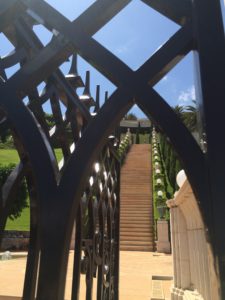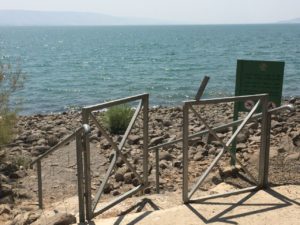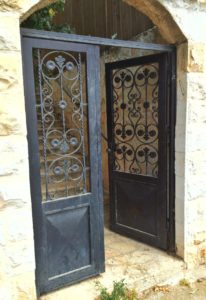We looked up at a flight of stone steps lined with beautiful houses, many of them decorated with bougainvillea, and other flowers with dazzling color. Udi continued, “We can continue with our plan or we can see where these steps lead.” It took only seconds for all of us to agree that this is exactly what we needed to do, so we passed through the gate, and were richly rewarded by our detour into the quiet and picturesque neighborhood of Yemin Moshe, with its quiet streets and breathtaking views of Jerusalem. After 20 minutes of exploring we continued on to the Old City.
Since that afternoon, I have been quite taken with gates and the metaphor that they represent. In the ancient world, gates were a boundary of protection for the residents of walled cities, with people and goods passing through controlled secure access points. Gates also protected people’s homes, and were identified in the Bible as a place where Jews are commanded to inscribe the word of God.
Gates remain a prominent architectural feature in contemporary Jerusalem neighborhoods. On Shabbat, it is common to see gates left ajar intentionally by a building’s residents so that it is not necessary to ring a doorbell, an activity prohibited in the traditional observance of Shabbat.
Whether in the ancient world or today, on Shabbat or during the week, gates mark a passage as we move from one place to another. If we approach a gate that is closed, we have reached a limit and must either move in a new direction or seek to be admitted. On the other hand, an open gate represents an opportunity. We are invited to consider whether we should stay on our present path, or consider what lies on the other side.
We are now nearing the end of the month of Elul, a time in the Hebrew calendar for pause and reflection before we enter the Days of Awe to begin a new year and engage in the painstaking spiritual work of Yom Kippur. During this time we take stock of our lives as they are, and how we wish them to be. We consider where we have missed the mark, but also where we do well in our dealings with other people. This period of reflection prepares us to move into Rosh Hashanah with focus and purpose.

Gate looking up Mount Carmel at the B’hai Gardens, Haifa. Photo: Howard Tam, Farm to Frame Photography.
Perhaps Elul is also a gate of sorts on our approach to the High Holy Days. We are invited to stop on our journey and take stock of where we’ve been and where we should go next. But the choice of direction is entirely up to us. We may continue on our way without taking notice of the gate. Or we can stop and reflect, and decide to pass through the open gate with trepidation as we move into Days of Awe, not sure of precisely where we will end up. This is tough work that requires great strength.
When we encounter the unplanned open gates of life, we are presented with moments that are pregnant with possibility. If we depart from our plans with intention and after careful consideration we can find ourselves deeply enriched with new experiences that we would not have if we played it safe.
May our year ahead be filled with health, prosperity, learning, and beautiful journeys dotted with many open gates. L’Shanah Tovah!
This is the fourth in a series of posts about life in Jerusalem through the eyes, ears and experiences of a first-year rabbinical student. The third post can be found here.



